
One of the most popular five-passenger crossovers on the market is the Hyundai Santa Fe, and for good reason. It has a lot of space compared to rivals like the Nissan Rogue since it can be seen as a very tiny midsize or a massive compact vehicle, depending on your viewpoint. Top-notch material quality and riding fineness are also present. Additionally, you may customize your Santa Fe with a selection of gas, hybrid, or plug-in hybrid electric (PHEV) powertrains, exactly like Toyota’s RAV4 and the Santa Fe’s corporate relatives, the Kia Sportage and Sorento. Gasoline variants are available with front- or all-wheel drive (AWD), while hybrid vehicles come standard with AWD.
There are five classifications for gas-powered engines. The SE trim ($29,785 including the $1,335 destination fee), SEL trim ($33,485), and XRT trim ($35,285) all come with the 191 horsepower 2.5-litre engine; Limited and Calligraphy variants, however, upgrade to the more powerful turbocharged engine, which is described below. The basic SE is significantly sluggish even though it offers good value. The SEL is the sweet spot since it has features like heated seats, a more prominent display, dual front temperature controls, an eight-way power driver’s seat with lumbar support, and more sophisticated cruise control. AWD adds $1,700 to the price of gasoline models.
An SEL with AWD costs more than a RAV4 or Sportage with AWD in this competitive sector, but it provides more technology and is about on a level with the Honda CR-V. The enjoyment is provided by the 2.5-liter Santa Fe turbocharged engine, which has 281 horsepower. Although it increases the ask by more than $6,000, it is approximately 100 HP more than the standard engine. Leather, heated, and ventilated seats and larger wheels are standard on Limited and Calligraphy variants. The Calligraphy FWD (panoramic glass roof, heads-up display, and eight-way power passenger seat) costs $43,635, while the Limited FWD costs $41,635.
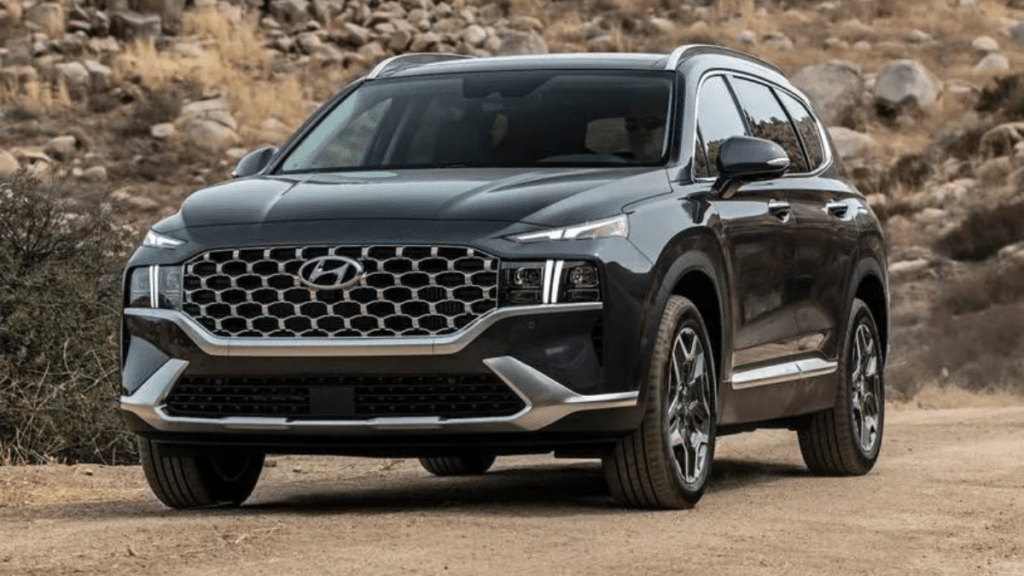
The Limited and Calligraphy provide smoother performance and replace the standard six-speed automatic with an eight-speed one. Although the feature set of these top trims may be comparable to that of an Audi Q5, their value decreases as they approach the price of an Audi Q5. However, even the standard Santa Fe, although less powerful, offers a steady, competent ride with tight, perhaps sporty characteristics on back roads comparable to its rivals.
The three tiers of the primary hybrids are Blue ($37,245), Premium ($41,105), and Limited ($42,905). Since the Blue has higher power than the base gas Santa Fe and includes all of the amenities described above for the gas SEL, it should be referred to as a “blue chip” vehicle. The hybrid drivetrain can produce 226 horsepower while achieving 36 city and 31 highway mpg. Going Blue is great if you’re not going basic SE or SEL.
SEL Convenience ($41,295) and Limited ($47,305) grades of the PHEV are currently only offered in a few locations. However, it is challenging to argue about PHEVs, particularly the Limited. It’s difficult to justify the roughly $10,000 price increase over the Blue, given the vehicle’s meagre 30 miles of electric-only range. With that exception, the remainder of the Santa Fe collection continues to provide value-packed features for which the company is recognized.
What’s New?
Hampton Gray, Calypso Red, and Stormy Sea are now available on hybrids, and both have a standard 10.25-inch touch screen with semi-automated highway mode (Highway Driving Assist) as well.
Cons & Pros
Pros
The more spacious end of the five-passenger crossover scale.
Two standard engines and two hybrid engines are available.
Excellent safety scores from IIHS and NHTSA.
Cons
Competitors provide greater fuel efficiency.
A $6k extra is levied for a desired turbocharged gas engine.
Base six-speed cannot compete with rivals’ eight-speeds.
Performance: Hyundai Santa Fe
Santa Fe has a divided personality, reflected in this score. Despite its size, the Santa Fe rides and turns nicely. However, it falls short of Toyota, Honda, and Kia in terms of effortless gear changes since the Hyundai’s lowest models are limited to a six-speed transmission. These three automakers instead provide CVTs (CR-V) or eight-speed messages. You must pay at least $41,595 for the vehicle to receive an eight-speed gearbox in Santa Fe. Even so, the standard 2.5-litre Santa Fe with 190 horsepower competes well with the 203-horsepower Toyota, 187-horsepower Sportage, and 190-horsepower Honda.
The Santa Fe awakens when the turbo motor is switched on but at an excessively high cost. Upgrade to AWD ($1700) for better performance and traction in all weather conditions, as it provides more driving modes. Smart distributes most of the power to the front wheels for greater fuel efficiency, while Comfort divides it 70/30 between the front and rear axles. Last, switch to Sport to send half the torque to the rear axle for improved traction and more precise handling. The Santa Fe seems a little zippier, albeit not quite sports car quick, thanks to Sport’s increased throttle tip-in.
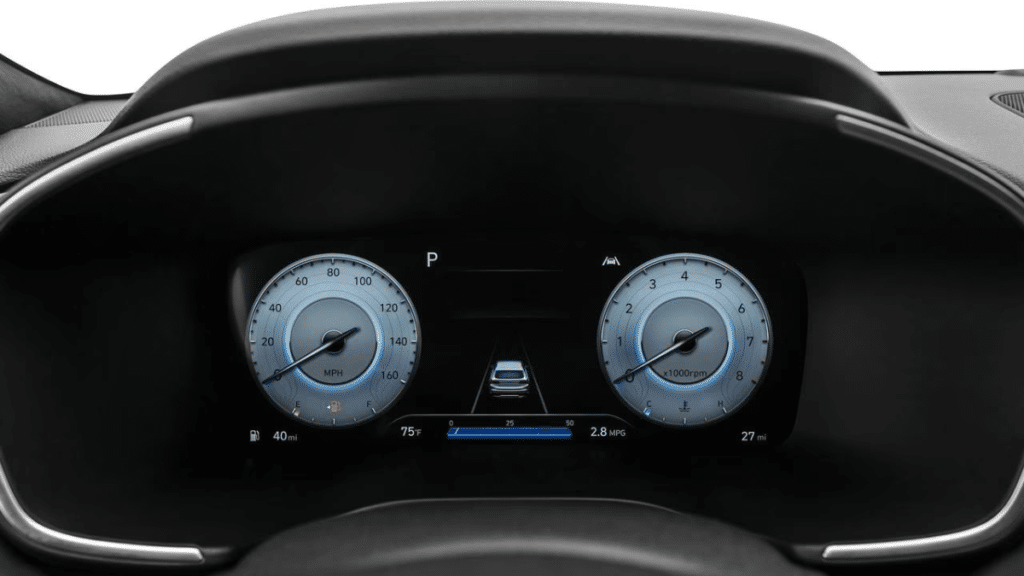
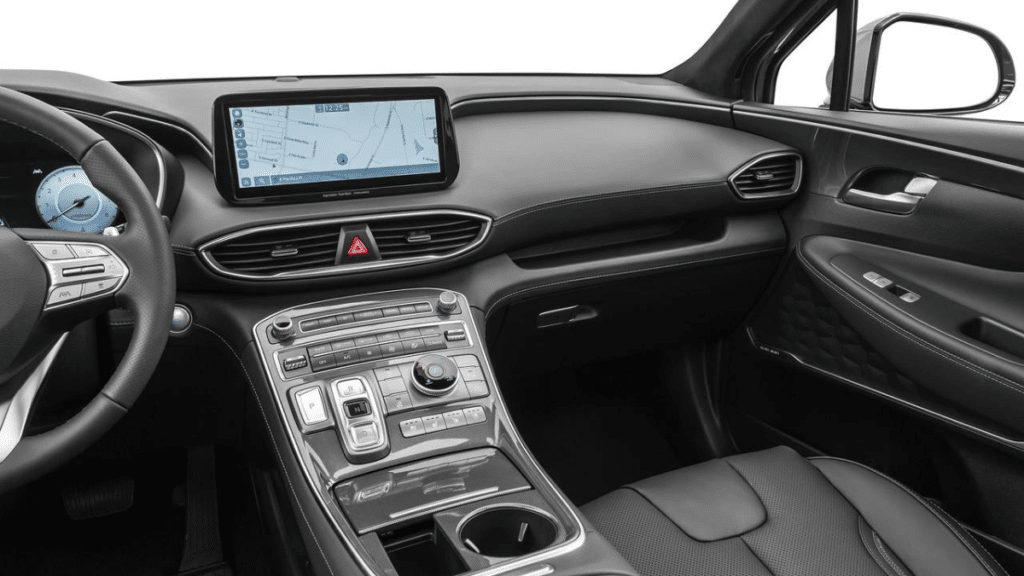
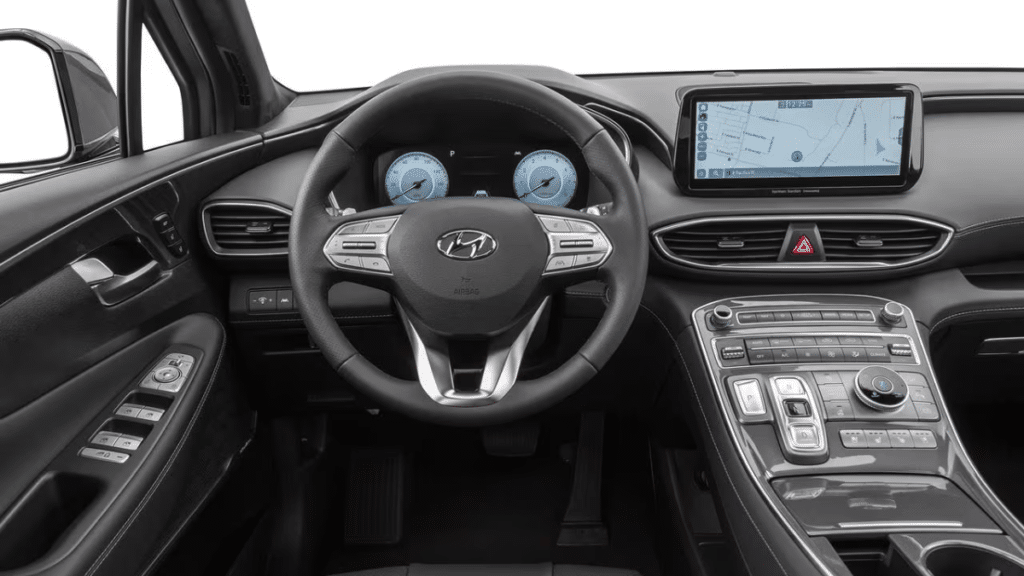

Fuel efficiency: Hyundai Santa Fe
Santa Fes that run on gas are less frugal than their counterparts. The 2.5-litre SE non-turbo achieves combined mileage ratings of 26, 25, and 28 mpg (24, 22, and 25 with AWD). The Honda CR-V is a little more frugal with fuel economy ratings of 30 mpg combined, 28 cities and 34 highways (29, 27, and 32 with AWD). The RAV4 achieves its most excellent combined mileage of 30 mpg, 27 towns and 35 streets. As predicted, the 2.5-liter turbo Santa Fe is less fuel-efficient, earning 25 mpg combined, 22 in the city and 28 on the interstate. The AWS version returns only one mpg in combined and city driving.
The Premium and Limited hybrids get 32 mpg combined (33 city, 30 highway), while the Santa Fe hybrid Blue gets 34 mpg combined (36 city, 31 highway). The AWD Sorento achieves similar fuel efficiency, but a front-drive hybrid version can get up to 37 mpg combined (39 cities, 35 routes).
Unfortunately for Hyundai, they’re still trying to surpass the top rating of 40 mpg combined (41 cities, 38 highways) achieved by the AWD RAV4 Hybrid. Another contender is the CR-V hybrid AWD, which achieves a combined 37 mpg (40 cities, 34 routes). The Sportage, which shares a hybrid engine with the Santa Fe, achieves 38 mpg in both the city and the highway.
The Santa Fe PHEV is only capable of 30 miles of EV-only range despite having a 76 MPGe rating (the number of miles the vehicle can travel using a quantity of fuel with the same energy content as a gallon of gasoline). What’s more worrying is that its 33 mpg combined fuel economy is slightly lower than the Santa Fe Blue’s 34 combined. When compared side by side, the Toyota RAV4 Prime achieves 94 MPGe, 42 miles of range for electric vehicles, and 38 mpg in regular driving.
Safety & Driver Support
The National Highway and Traffic Safety Administration (NHTSA) awarded the Hyundai Santa Fe its highest possible five-star rating and an IIHS Top Safety Pick+.
The list of available safety features is extensive. It includes features like adaptive cruise control with stop and go, automatic emergency braking with pedestrian and cyclist detection, blind-spot warning with collision avoidance braking, and rear cross-traffic alert, the latter of which is not standard on all five-passenger crossovers at their base retail. There is also a safe exit assist, which employs the back and side cameras to monitor that area and stop a passenger door from being opened to prevent a child from getting out of a vehicle into moving traffic.
On the highway, lane-keeping assistance, lane following, and adaptive cruise control work together to keep your Santa Fe on the straight and narrow; a driver alert monitor may detect when you need to rest. Additionally, standards are automatic high beam dimmer, illumination, and LED headlights.
The Santa Fe is loaded with a ton of standard safety technology from Hyundai. Aside from the more space for the money, the number of standard safety technology is the only selling feature.
Comfort and Space
Although the most recent Honda CR-V has been improved in that area, Hyundai still wins the inside quality test thanks to plastics that feel a half-grade higher than those of competitors. But Hyundai’s designers achieved the ideal mix between a little techy feeling and warmer, homely elements, and it all works. This is a comfortable cabin that’s a little bit posh in addition to being utilitarian. To save space in the centre console cupholders for your home keys, food, etc., on-door cupholders are, for example, more than big enough for a sizeable drive-through beverage or your favourite giant water bottle. Then, an extra-large tray fits even a big purse between the two front seats.
Even though the hybrid reduces it to 40.8 inches for the second row, there is still plenty of legroom in both the front and back, measuring a very generous 44.1 inches in the front and 41.7 inches in the back. These figures contrast nicely with the Honda CR-V’s 41.3 inches front and 41 inches back legroom. Although the 41 front and 37.8 back inches of the RAV4 are not insignificant, more prominent people will find the Santa Fe accommodations quite accommodating.
All of the seats are well-bolstered, and the second row, in particular, benefits from hip space that is broader than typical.
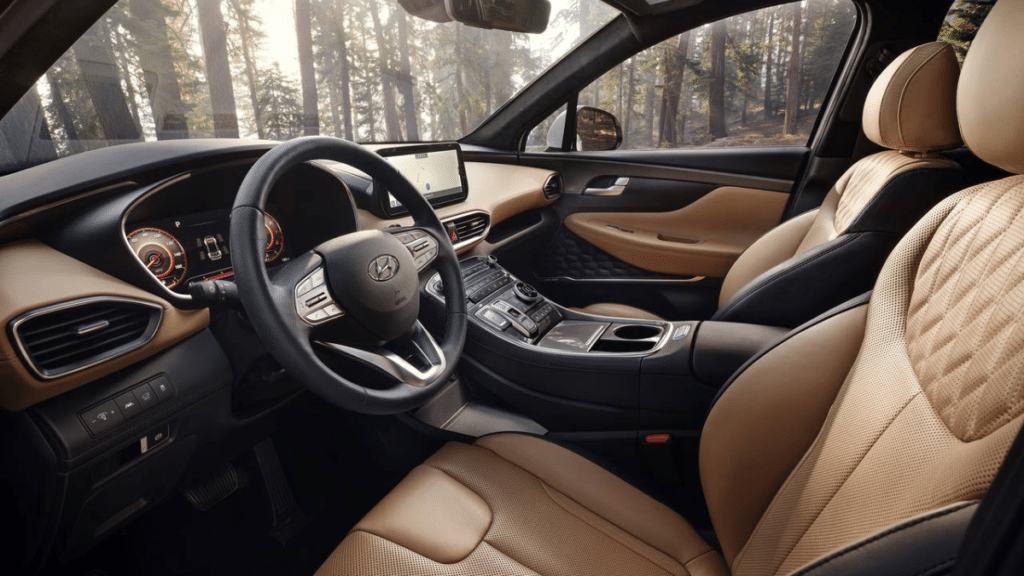


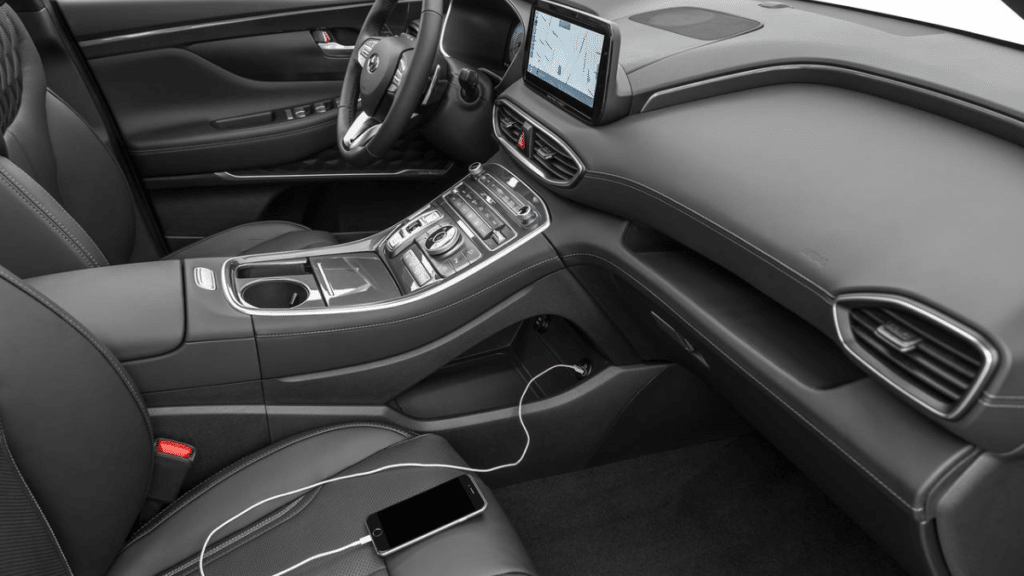
Infotainment: Hyundai Santa Fe
With Santa Fe, you get a ton of electronics as standard. Although we’ve complained about other cars for hiding everything behind a touchscreen, the Santa Fe makes sure you have a button or dial for almost every function. That’s particularly useful for quickly changing the radio’s audio mode, tuning to the appropriate station, and switching entertainment modes from the standard Android Auto or Apple CarPlay to the stock Android Auto or Apple CarPlay. The giant 10.25-inch touchscreen and wireless phone charging are obvious reasons to go from the SE to the SEL, and every version except the SE also comes with navigation.
Mode, volume, and other functions are controlled by redundant switchgear on the steering wheel. However, these symbols might be difficult to see in direct sunlight.
Although dual USBs avoid second-row seat fights between your children in the front and back, you may want to spend an extra $4,650 to upgrade to an SEL Santa Fe. This includes everything from the impressive 12-speaker Harman Kardon sound system to the essentially insignificant auto-dimming rearview mirror, which practically no consumer would spend more than $500 (but not four thousand) for.
Storage & Cargo Space:
It has plenty of area for carrying stuff. You have 36.4 cubic feet to work with while the back seats are upright and 72.1 cubic feet when they are folded. While the RAV4’s 37.5 cubic feet with its rear seats fixed also holds up well, the RAV4’s maximum of 69.8 cubic feet falls significantly short of this group; the Kia Sportage’s 34.5 and 73.7 cubic feet almost equal the Hyundai. The slightly bigger Honda CRV wins the award with 76.5 cubic feet, with the second row folded and 39.3 cubic feet behind it.
Once again, all of these figures are pretty close. But Hyundai is commended for its design. One lever, for instance, may be pulled once to lower and once again to elevate a rear seatback. Additionally, they fold entirely flat, so you don’t lose storage space due to a “ski ramp” effect. Slipping anything bulky or heavy onboard is much simpler if the hatch door lid and load floor become fully level.

Design: Hyundai Santa Fe
The 2023 Santa Fe hasn’t seen many significant modifications from Hyundai; instead, the top-tier Santa Fes now gets new wheels in addition to LED running lights, a blacked-out grille, and other cosmetic sheening. This isn’t necessarily a negative thing; Hyundai nipped and tucked the fairly nondescript style when the Santa Fe was last updated in 2021 to make place for the Palisade above it, and the most recent Santa Fes appear a bit sharper and a little more Premium.
The Santa Fe is it beautiful? Nope, but the Ford Bronco Sport, the only stylish crossover in the class, is slightly smaller and doesn’t ride as smoothly as the Santa Fe. The look is designed for city living overall. Hyundai knows its consumers don’t compare Jeep Wranglers and Ford; Santa Fe is probably not for you if you do.
If there is a hidden rival in the interior market, it may be Mazda’s CX-5. The sleek dashboard execution of that vehicle resembles the Hyundai’s techy, lively design rather than 1s and 0s cold, even those overall cargo capacity. The difference is significant since the former should age gracefully while the latter won’t.
Which is the best-value Hyundai Santa Fe model?
The basic engine, SE trim, or maybe SEL will provide the most excellent value for Santa Fe. Get either model’s $1,700 AWD option if you want or need all-season capabilities.
But remember that the SEL with AWD costs $34,845, and its average 22-city/25-highway MPG isn’t spectacular. The $37,245 hybrid Blue model is here. This contains everything on the SEL, such as heated seats, but with 226 horsepower total and substantially higher fuel efficiency (36 cities and 31 highways).
The Blue is still less costly than the turbocharged Santa Fes. It has options like an auto-dimming rearview mirror, heated side mirrors, and an extra-large, 12.3-inch digital instrument cluster that Hyundai reserves for its gas-powered vehicles. It costs $4,650 as part of an upgrade package.
Do we believe that the price of the hybrid is a mistake? It’s the best way to increase power, panache, and features without spending more than $40,000, not even much.

How Much Will It Cost Me to Insure a Hyundai Santa Fe in 2022?
Santa Fe should have comparable insurance costs to most of its competitors. The average yearly Premium for a 30-year-old female driver with a clean driving record is around $1,861 for the basic SE and steadily goes to $2,137 for the Calligraphy. However, this figure includes all 50 states. For instance, a Toyota RAV4 LE owner may spend $1,840 yearly, but the Honda CR-V costs between $1,722 and $1920, depending on grade.
Verdict
The Santa Fe offers a variety of drivetrain options, including conventional, hybrid, plug-in hybrid (PHEV), and powerful turbocharged engines. The spacious five-passenger family crossover also includes a few standard technological and security features. However, You still have to choose which extras to purchase. For example, the excellent quality audio is somewhat pricey. Just be aware that the turbo engine is far superior, and the regular Blue hybrid may provide the most significant overall value, while the base engine is acceptable but uninspiring.




